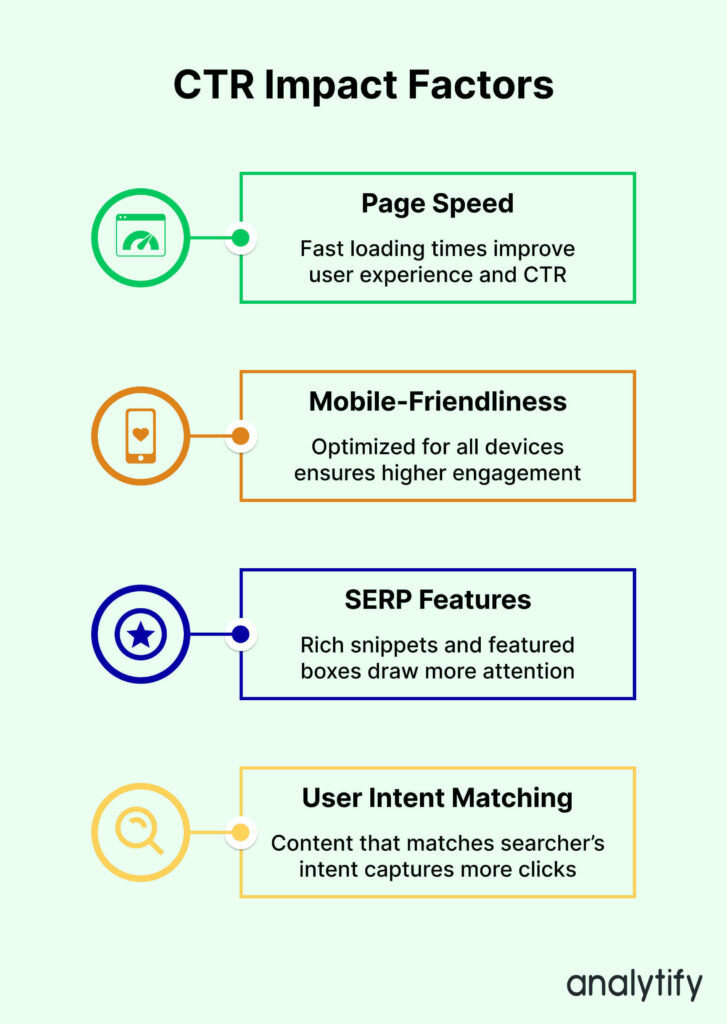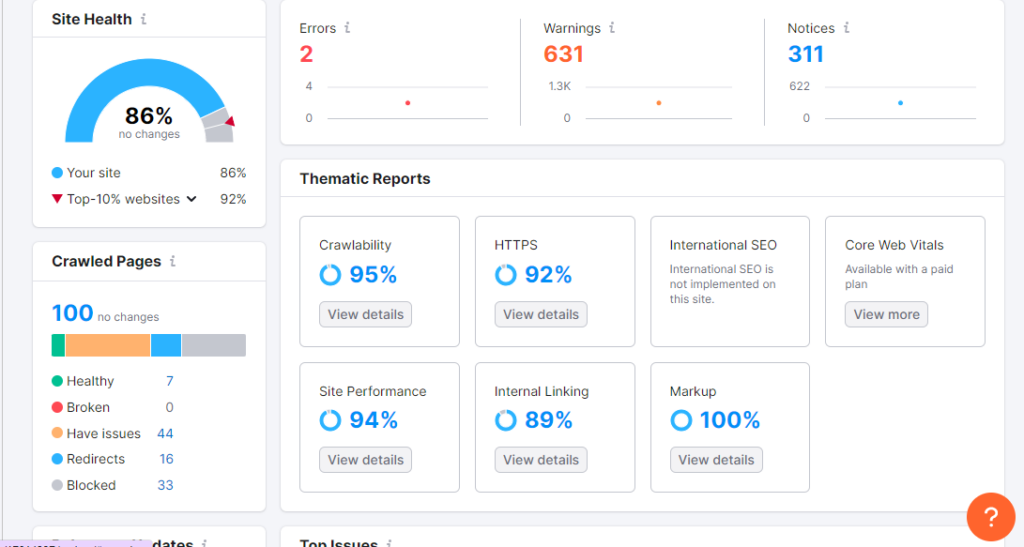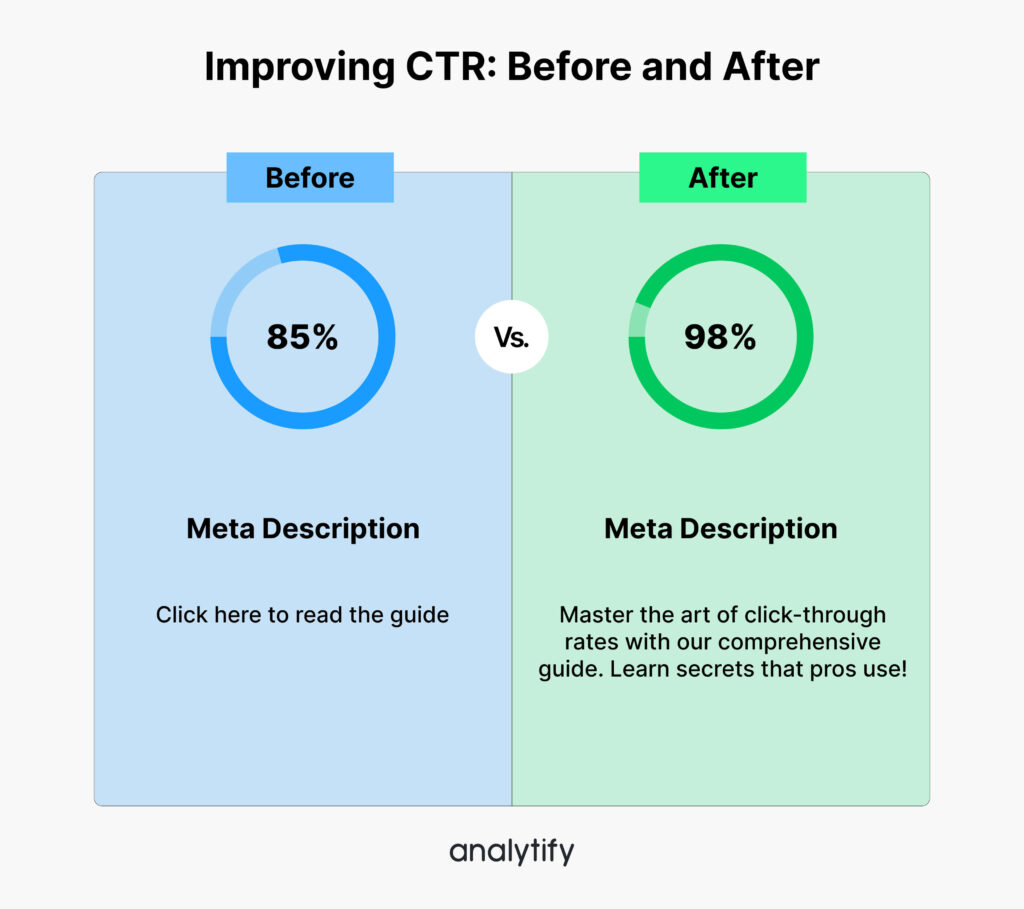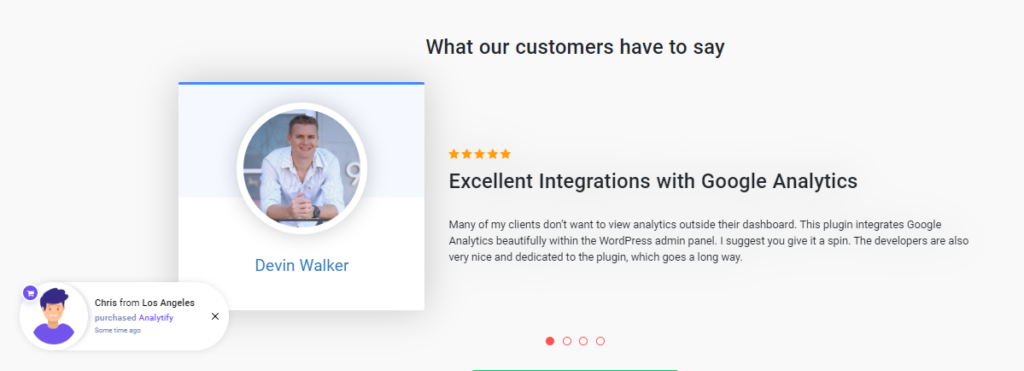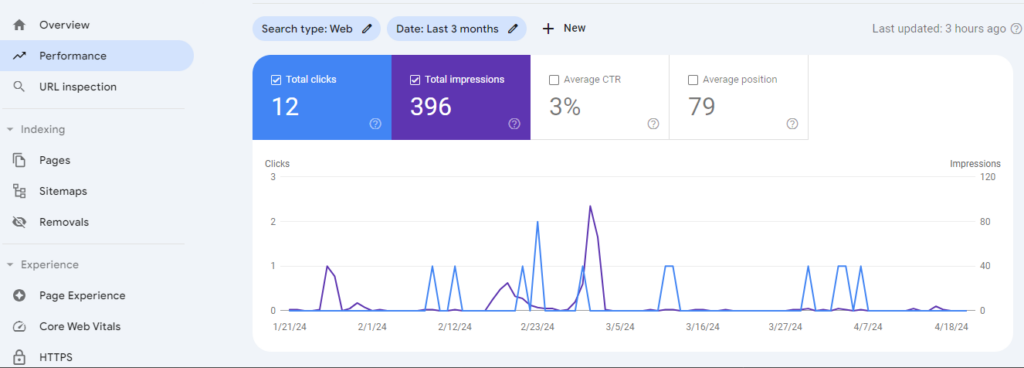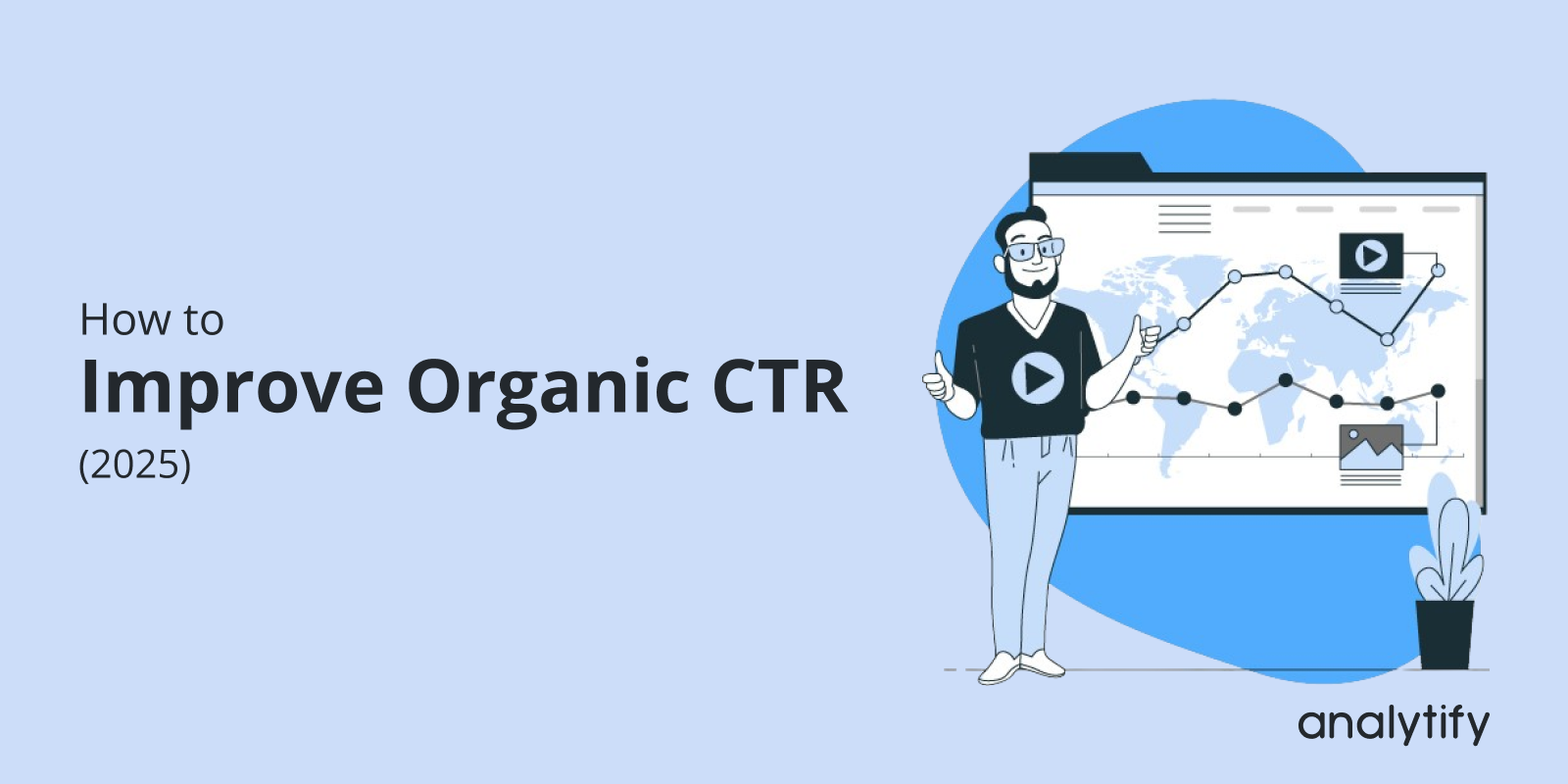
How to Improve Organic CTR (15 Proven Strategies)
Are you looking to improve organic CTR and boost your website’s visibility? Make sure to read this blog post till the end!
Whether you’re an expert marketer or just dipping your toes into the vast ocean of SEO, understanding your organic clickthrough rate (CTR) is important. Because it’s a clear indicator of how well your pages resonate with users’ queries and expectations.
In this article, we will break down everything you need to know about organic CTR, from the basics of what it is, why it matters and the top strategies to improve it.
Organic Clickthrough Rate (TOC):
What is Organic CTR?
Organic CTR, or organic clickthrough rate, is the percentage of users who click on your website’s listing in search engine results after seeing it. Simply put, it’s a measure of how enticing your search result is to users who come across it. Think of it like this: if your page shows up 100 times, and 5 people click on it, your organic CTR is 5%.
Why does this matter? A high organic CTR implies that your page is relevant to what searchers are looking for, and that your title and description are appealing enough to encourage clicks. On the flip side, if your CTR is low, it might be a sign that your page isn’t resonating with what users expect or need, or your listing doesn’t stand out enough among the crowd.
How is Organic CTR Calculated?
The formula for calculating organic CTR is straightforward:
Organic CTR = (Number of Clicks/Number of Impressions)×100
- Number of Clicks: How many times have users clicked on your search listing
- Number of Impressions: How often was your listing viewed on the search engine results page (SERP)
To make this a bit more visual, let’s look at an infographic that breaks down the average CTR for organic search across different industries. It helps consider what a good organic CTR might look like for your specific sector.
How to Determine Your Organic CTR
Understanding your organic CTR is one thing, but how do you actually figure it out for your website? The best tool for this job is Google Search Console (GSC). GSC gives direct insights into how your site performs in Google search results.
Using Google Search Console to Track Organic CTR
Here’s a quick step-by-step guide on how to use Google Search Console to check your organic clickthrough rate:
- Log in to Google Search Console: Start by accessing your GSC account. If you don’t have one, set up Google Search Console for your website.
- Select ‘Performance’ Report: Once logged in, navigate to the Performance tab. This section provides data about your site’s performance in Google’s search results.
- Check Your Metrics: Ensure that the ‘Total Clicks’ and ‘Total Impressions’ options are ticked. These metrics are necessary for calculating your CTR.
- View Your CTR: Below the graph that displays clicks and impressions over time, you’ll find the average CTR for your site. You can also filter this data by queries, pages, countries, devices, and more to get more granular insights.
Pro Tip: Analyse the CTR for individual pages or specific queries to identify which parts of your site might need more attention in terms of SEO and content optimization.
Regularly monitoring your organic CTR through Google Search Console allows you to spot trends, make informed decisions about your SEO strategy, and improve organic CTR.
What is a Good CTR for Organic Search?
Defining a “good” organic CTR can vary widely depending on several factors, such as your industry, the type of queries (navigational, informational, transactional), and even the position of your listing on the search results page. However, having a benchmark can help you set realistic expectations and goals for your SEO efforts.
Industry Benchmarks for Organic CTR
Here are some generalized benchmarks for average CTR for organic search across different industries:
- E-commerce: Average CTR is around 2.69%. Higher CTRs are typically seen on product-specific searches.
- B2B (Business to Business): Here, the average CTR might hover around 2.5%, as queries are often more information-driven.
- Local services: For local searches like “plumbers near me” or “best coffee shop in town,” the CTR can be as high as 5-10% due to the searcher’s high intent.
- Blogs: The average CTR for blogs is 1-5%.
Factors That Influence a Good CTR
- Search Intent: Understanding the intent behind the searches can help tailor your metadata and content to meet users’ needs in a better way.
- SERP Features: The presence of features like featured snippets, local packs, or shopping ads can affect CTR. For example, a featured snippet can boost your CTR significantly.
- Device Usage: CTR can also vary between devices. Mobile searches often have higher CTRs than desktop searches, especially for local services.
Why is Your Organic CTR Important?
Boosting your organic CTR isn’t just about getting more clicks; it’s about attracting the right kind of traffic that can lead to higher engagement and conversions. Here are several reasons why optimizing your organic CTR should be a key component of your digital marketing strategy:
Key Reasons to Optimize Your Organic CTR
- Higher Search Rankings: While Google has stated that CTR isn’t a direct ranking factor, there’s evidence to suggest that pages with higher-than-average CTRs may receive a ranking boost. If more users click on your results, it signals to Google that your page is likely relevant to users’ queries.
- Increased Organic Traffic: This one is straightforward. The more users click on your search listings, the more organic traffic your site receives. It can lead to more opportunities for conversions and sales.
- Better User Engagement: A high CTR often correlates with content that resonates well with your audience. It indicates that your titles and descriptions are compelling and relevant, which can lead to more extended site visits and lower bounce rates.
- Cost Efficiency: Improving your organic CTR can be a cost-effective strategy compared to paid search campaigns. By optimizing what you already have, you enhance the potential of your existing assets without additional spending.
CTR and User Experience
Enhancing your CTR also impacts the user experience. By ensuring that your listings accurately reflect the content on your page, you align user expectations with reality, leading to a more satisfactory user experience. This trust-building contributes to brand loyalty and return visits.
Understanding and improving your organic CTR is about more than just boosting numbers; it’s about enhancing your website’s overall quality and relevance in the eyes of both users and search engines.
Top Factors Affecting Organic CTR
Several elements influence how likely users are to click on your search results. Understanding these can help you fine-tune your strategy to maximize your organic clicks. Here are some of the most critical factors:
- Title Tag and Meta Description:
These are the first things a searcher sees. A well-crafted title and description can make the difference between a click and a pass. Use emotional triggers, clear value propositions, and call-to-action phrases.
- URL Structure:
A clean, keyword-relevant URL suggests that your site is what the searcher is looking for. Avoid long, cluttered URLs that can confuse users.
- SERP Features:
Your ability to feature in rich snippets, local packs, or other SERP features can dramatically increase your CTR. These features make your listing more prominent and attractive.
- Search Query Relevance:
The more your content aligns with the searcher’s intent, the higher your chances of getting clicked. Tailor your content to match the expectations and needs of your target audience.
- Mobile Optimization:
With the increasing dominance of mobile searches, having a mobile-friendly website is essential. Mobile users tend to have different behaviors and preferences, affecting CTR.
- Brand Recognition:
Recognizable brands often have higher CTR because of the trust factor. Work on building your brand through a consistent online presence and quality content.
To help visualize how these factors can affect CTR, here’s a table summarizing their potential impact on user clicks:
| Factor | Description | Impact on CTR |
| Title Tag and Meta Description | First impressions matter; make them count. | High |
| URL Structure | Keep it clean and relevant. | Medium |
| SERP Features | Aim for visibility through rich snippets and more. | Very High |
| Search Query Relevance | Align content with user intent. | High |
| Mobile Optimization | Optimize for the growing mobile user base. | High |
| Brand Recognition | Build trust and recognition. | Medium to High |
By focusing on these factors, you can effectively boost your organic CTR, leading to better search performance and more qualified traffic to your site.
How to Improve Organic CTR: 15 Best Tips and Practices
Improving your organic CTR involves a mix of SEO enhancements, technical optimizations, and content strategies.
Here are 15 expert tips to effectively boost your click-through rates:
1. Conduct a Website Audit
A thorough website audit helps identify potential SEO issues impacting your Organic CTR. Understanding and addressing these issues can enhance user experience and improve your site’s search results performance.
Steps to Conduct a Website Audit:
- Step 1: Use a Comprehensive Tool: To perform a detailed analysis of your site, start with a tool like Semrush’s Site Audit.
This tool scans for issues affecting SEO, such as slow page load times, poor mobile usability, duplicate content, and more.
- Step 2: Analyze the Report: Focus on critical errors that might directly impact user experience and search rankings. Common issues include:
- Slow Page Load Times: According to a consumer insights platform 47% of consumers expect a web page to load in 2 seconds or less. Pages taking longer can have bounce rates as high as 38%.
- Duplicate Title Tags and Meta Descriptions: Websites with duplicate title tags can suffer a decline in CTR by up to 20%, as they may appear less relevant or spammy to users.
- 404 Errors: Pages that return 404 errors can lose up to 100% of their organic traffic, directly affecting your site’s CTR and rankings.
- Step 3: Address Technical SEO Issues: Tackle issues like 4xx errors, broken links, and incorrect robot.txt settings. Each of these can prevent search engines from properly crawling and indexing your pages, thus reducing their chances of appearing in search results.
- Step 4: Optimize for Speed and Mobile Usability: Since over 50% of worldwide traffic comes from mobile devices, ensuring your site is optimized for mobile is crucial. A one-second delay in mobile load times can impact up to 20% conversion rates.
Other Resources to Use:
- Google PageSpeed Insights: Use this tool to get detailed reports on your pages’ performance on mobile and desktop devices, along with suggestions for improvement.
- Mobile-Friendly Test by Google Search Console: Checks how easily a visitor can use your page on a mobile device. Read how to Setup Google Search Console for your WordPress site.
Implementing Changes:
- Fix Page Errors: Address any 404 and 401 errors by either fixing the link or setting up proper redirects.
- Optimize Load Times: Compress images, leverage browser caching, and minimize JavaScript and CSS.
- Update and Optimize Content: Refresh outdated content, optimize title tags, and ensure all meta descriptions are unique and engaging.
By conducting a regular website audit and addressing the highlighted issues, you can significantly enhance your site’s user experience, improve your Organic CTR, and boost your overall SEO performance. Regular audits ensure your website remains compliant with best SEO practices and adapts to ongoing search algorithm updates.
2. Optimize Title Tags
The title tag is one of the most crucial elements for SEO and improving Organic CTR. It’s the first thing users see in the search results, significantly influencing whether they click on your link.
Importance of Optimized Title Tags:
- Direct Impact on CTR: A compelling title tag can make the difference between a user clicking on your result or choosing a competitor’s.
- SEO Relevance: Title tags help search engines understand what your page is about and are a critical factor in ranking.
How to Optimize Title Tags:
- Include Target Keywords: Place your main keyword towards the beginning of the title to signal its relevance to search engines and users.
- Be Descriptive and Concise: Ensure your title accurately reflects the content of the page. Keep it under 60 characters to ensure it displays fully in the SERP without being cut off. You can use Spotibo to check the preview of Google search results.
- Use Emotional Triggers: Words like “Ultimate”, “Essential”, “Easy”, or “Quick” can provoke curiosity or urgency, making users more likely to click. You can check the Headline Studio Tool for scoring and suggestions about emotional, uncommon and power words.
- Avoid Duplication: Each page should have a unique title tag to prevent cannibalization and confusion in search rankings.
- A/B Testing: Experiment with different variations of your titles to see which ones generate a higher CTR.
Let’s suppose an example to improve a tile. Instead of creating a title, “Home – XYZ Company”, we recommend you use “Discover Affordable Luxury Watches – XYZ Company”
Implementation Steps to Optimize Title Tags:
- Review Existing Titles: Assess current titles across your site for improvements.
- Incorporate Keywords: Modify titles to include relevant keywords without stuffing.
- Apply Emotional Triggers: Add compelling elements to engage potential visitors.
- Monitor and Adjust: Use analytics to track performance and refine as needed. If you have a WordPress site, you can check analytics directly from the WordPress dashboard using Analytify.
Optimizing your title tags is a simple yet effective way to directly influence your Organic CTR, driving more traffic to your site without the need for additional resources.
3. Enhance Meta Descriptions
While meta descriptions do not directly impact SEO rankings, they are important in influencing Organic CTR. A well-crafted meta description acts as an advertisement for your page, attracting users to click through from the search results.
Importance of Meta Descriptions:
- User Engagement: A compelling meta description can distinguish between a user clicking on your listing or skipping it.
- Visibility: While not a ranking factor, a good meta description can increase the visibility of your keywords when they are bolded in search results, aligning with user queries.
How to Optimize Meta Descriptions:
- Audit Existing Meta Descriptions: Identify pages with weak or missing meta descriptions.
- Draft Compelling Copy: Write meta descriptions that accurately reflect the page’s content and include a motivational element.
- Include Targeted Keywords: Incorporate keywords naturally. Google often highlights these keywords in bold within the search results, making your listing stand out more.
- Provide Clear Value: Explain what users will gain by visiting the page. For example, if the page is a guide, highlight what knowledge they will acquire.
- Use Action-Oriented Language: Include a call-to-action like “Learn more,” “Get started,” or “Discover how” to encourage users to take the next step.
- Keep It Within Limit: Keep your meta descriptions around 155-160 characters to ensure they are not cut off in the search results.
- Google Search Console: Review which pages have low CTR and might benefit from updated meta descriptions.
For example, instead of writing, “Click here to read more,” you can write, “Explore the ultimate guide to mastering your SEO skills and boost your website traffic today!”
Well-optimized meta descriptions can improve CTR by approximately 5-10%. They provide a better understanding of the webpage content and encourage more qualified clicks.
4. Improve URL Structure
A well-structured URL not only helps search engines understand the relevance of your content but also influences user perception, making it an essential factor for improving Organic CTR.
Importance of URL Structure:
- User Trust and Clarity: Clean and descriptive URLs give users a clear idea of what to expect on the page, which can increase their likelihood of clicking the link.
- SEO Benefits: A well-structured URL can enhance your SEO efforts by including relevant keywords that further align with search queries.
How to Optimize URL Structure:
- Audit Existing URLs: Review the current URL structure across your site and identify URLs that could be simplified or more descriptive.
- Use Keywords: Include relevant keywords in your URLs to improve their discoverability and relevance to the content. Ensure these keywords naturally reflect the page’s content.
- Keep it Short and Simple: Aim for concise URLs that are easy to read and understand. Avoid long strings of numbers, characters, or unnecessary parameters.
- Use Hyphens to Separate Words: Use hyphens (-) instead of underscores (_) to separate words, as search engines prefer this formatting for readability.
- Follow a Logical Structure: Your URLs should reflect the architecture of your website, helping users and search engines navigate the site hierarchy. For example, www.example.com/category/subcategory/product.
- Google Search Console: Analyze ‘Performance’ reports to see how different URLs perform regarding clicks and impressions and identify potential improvements.
Let’s consider an example of an Optimized URL,
- Before Optimization: www.example.com/index.php?product=123&user=456
- After Optimization: www.example.com/mens-casual-shirts
Improving your URL structure can significantly impact user experience and SEO. Clear, descriptive, and keyword-relevant URLs are more likely to earn clicks and improve your site’s visibility in search results.
5. Target Featured Snippets
Featured snippets, often called “Position Zero,” are excerpts from web pages that appear at the top of Google’s search results. They are designed to directly answer a searcher’s query, making them highly coveted for increasing visibility and CTR.
Why Featured Snippets Boost CTR:
- Increased Visibility: Featured snippets are displayed prominently at the top of search results, often with additional formatting and imagery.
- Authority Positioning: Appearing in a featured snippet can position your site as an authoritative source on the topic.
- Higher Engagement: A HubSpot study shows that featured snippets can increase CTR by as much as 114% as they draw user attention and provide immediate answers.
- A study showed that a well-optimized featured snippet could improve CTR from 2% to 8%, significantly boosting organic traffic.
How to Optimize for Featured Snippets:
- Identify Opportunities: Use tools like Semrush’s Organic Research or Google Search Console to identify queries for which Google displays featured snippets. Look for questions related to your content that drive traffic to your site.
- Format Content Appropriately: Structure your content to answer questions directly. Use clear, concise answers placed near the top of your content. Use formatting that aligns with the type of snippet you’re targeting (paragraph, list, table).
- Use High-Quality Images: When relevant, include high-quality images that match the snippet’s content. Google sometimes pairs images with the text in the featured snippet, enhancing its appeal.
- Keep Content Fresh: Google prefers fresh, up-to-date content for featured snippets. Regularly update your posts to maintain their relevance and accuracy.
- Google’s “People Also Ask” Boxes: Analyze related questions in these boxes to identify additional snippet opportunities.
By effectively targeting featured snippets, you can significantly enhance your site’s visibility, improve your organic CTR, and establish your brand’s authority in your niche.
5. Use Structured Data
Structured data is a standardized format for providing information about a page and classifying the page content. This is crucial for helping search engines understand the context of your content, which can lead to richer search results and potentially improve your CTR through enhanced features like rich snippets.
Implementing structured data can lead to an increase in CTR by up to 30%, especially when rich snippets appear in search results. They make the listings more attractive and can significantly increase the likelihood of clicks.
Importance of Structured Data:
- Enhanced SERP Features: Structured data can enable special search result features and enhancements such as rich snippets, which include stars for reviews, prices for products, or images for recipes.
- Increased Relevance: Structured data provides search engines with detailed insights into your page’s content, helping to display your page more prominently for relevant queries.
How to Implement Structured Data:
- Identify Appropriate Schema: Depending on the nature of your business and content, choose the most relevant schema.org markup for your content (e.g., Article, Product, Review).
- Implement Markup: To add structured data to your HTML, use JSON-LD, Microdata, or RDFa. Google recommends JSON-LD because it’s easier to add and maintain.
Example:
- Before Implementation: A product page without any structured data.
- After Implementation: The same product page with structured data showing price, availability, and ratings in search results.
Structured data helps improve CTR and enhances the overall visibility and attractiveness of your search listings. It’s an essential element of modern SEO strategies, particularly for sites that stand out in rich search results.
7. Optimize for Mobile
With the increasing prevalence of mobile internet usage, having a mobile-optimized website is necessary for enhancing user experience and improving Organic CTR. Mobile optimization can lead to significant improvements in user experience, which in turn can increase your Organic CTR. Websites optimized for mobile can see up to a 30% improvement in CTR compared to non-optimized sites.
Almost 61% of potential mobile customers are more likely to contact your local business if you have a mobile-friendly website (BrightLocal).
Importance of Mobile Optimization:
- Mobile First: Google indexes websites based on their mobile version first. A well-optimized mobile site is essential for good SEO performance.
- User Experience: A mobile-friendly website provides a better browsing experience, reducing bounce rates and potentially increasing CTR from mobile users.
How to Optimize for Mobile:
- Assess Mobile Usability: Use tools like Google Search Console Mobile-Friendly Test and SE Ranking’s Mobile Friendliness Checker to identify areas for improvement.
- Responsive Design: Ensure your website design adjusts seamlessly to fit different screen sizes and orientations. Responsive design uses a single URL and HTML code for all devices, which enhances SEO and maintains your CTR.
- Speed Optimization: Mobile users expect quick loading times. Use techniques such as compressing images, leveraging browser caching, and minifying CSS and JavaScript to increase page speed.
- Simplify Navigation: Mobile screens are smaller, so it’s crucial to have a simple and easy-to-use navigation menu. Consider features like a hamburger menu, which consolidates links without overwhelming the user.
- Accessible Design: Make sure buttons and links are easy to tap and text is readable without zooming. This usability can significantly affect user engagement and CTR.
Example:
- Before Optimization: A website that loads slowly on mobile, with text too small to read and links too close together.
- After Optimization: A fast-loading website with larger text, appropriately spaced links, and a simplified navigation structure.
Optimizing your site for mobile is beneficial for SEO and Organic CTR; it’s essential in today’s mobile-centric world, where most users will likely interact with your site through their mobile devices.
8. A/B Test Your SERP Elements
A/B testing, also known as split testing, is a method of comparing two versions of web pages or elements to see which one performs better. It’s a powerful method for optimizing elements in search engine results pages (SERPs), such as title tags, meta descriptions, and URLs.
Importance of A/B Testing:
- Data-Driven Decisions: A/B testing allows you to make changes based on actual performance data, rather than assumptions.
- Optimize CTR: By testing different variations, you can determine which elements appeal most to your audience, leading to higher click-through rates.
How to Conduct A/B Testing on SERP Elements:
- Plan Your Test: Identify which elements are most likely to influence user behavior and define your hypotheses.
- Run the Test: Allow sufficient traffic to each variant to gather meaningful data.
- Select a Variable to Test: Choose one element to change at a time, such as the title tag, to isolate the effect of that variable.
- Create Two Variants: Develop two versions (A and B) with just one change between them. For example, test two different title tags for the same page.
- Use Appropriate Tools: Implement your test using tools that can direct traffic equally to both page versions. Google Search Console can help measure the results by tracking clicks and impressions for each variant.
- Analyze the Results: Compare the performance of each variant in terms of CTR and other relevant metrics. Determine which version achieves a higher CTR and implement it for all users.
Example:
- Before Testing: Title A: “Buy Coffee Online – Best Prices Guaranteed”
- After Testing: Title B: “Discover Premium Coffee Beans – Shop Now”.
By systematically using A/B testing for your SERP elements, you can incrementally improve your Organic CTR, enhancing both your traffic and search engine visibility.
9. Focus on User Intent
Understanding and matching the user intent behind search queries is crucial for increasing Organic CTR. When your content closely aligns with what searchers are looking for, they are more likely to click on your result in the SERPs.
Importance of User Intent:
- Increased Relevance: Content that matches user intent is more likely to satisfy the searcher’s needs, leading to higher engagement and CTR.
- Better Rankings: Google prioritizes content that best satisfies user intent, which can lead to higher positions in search results.
How to Optimize for User Intent:
- Conduct Intent Analysis: Use keyword research tools to identify the intent behind your target keywords.
- Review Existing Content: Evaluate whether your current content meets the identified intents.
- Identify Types of Intent: User intent can generally be categorized into informational, navigational, transactional, or commercial categories. Determine the intent behind the keywords you target.
- Create Matching Content: Answer informational queries clearly and detailfully. Highlight products or services with a strong call to action for transactional queries.
- Use Appropriate Formats: Adjust your content format depending on the intent. For example, use how-to guides for informational queries and product comparisons for commercial searches.
- Optimize SERP Snippets: Tailor your title tags and meta descriptions to clearly reflect user intent. It will help users know immediately that your content matches what they’re searching for.
- Keyword Research Tools: Use tools like Semrush, SE Ranking, Ahrefs, or Analytify to analyze the keywords and understand the underlying intent by examining the SERP features and the content of top-ranking pages.
Example:
- Before Optimization: A page targeting the keyword “iPhone review” merely lists product specifications.
- After Optimization: The same page provides an in-depth review, comparisons with other smartphones, and user testimonials, matching the commercial investigation intent.
Optimizing for user intent enhances CTR and improves the overall user experience. Your site is more likely to fulfill visitors’ needs and encourage them to return.
10. Use High-Quality Images in SERP Listings
Visuals play a crucial role in attracting attention to search results. Incorporating high-quality images relevant to your content can significantly enhance visibility and encourage more clicks.
Importance of High-Quality Images:
- Visual Appeal: A compelling image can grab a user’s attention faster than text alone, which is critical in the crowded SERP space.
- Enhanced Engagement: Images can convey emotions and information quickly, leading to higher engagement and CTR.
How to Optimize Images for SERP:
- Audit Existing Images: Review the images used in your top-ranking pages and assess their quality and relevance.
- Update or Replace Images: Upgrade low-quality images with high-resolution, more appealing, and relevant versions.
- Use Relevant Images: Ensure each image is highly relevant to the page content. This relevance can help convey the context to users before they click, improving the likelihood of clicks from interested users.
- Optimize Image Quality and Size: Use high-resolution images and optimize them for fast loading. Tools like TinyPNG or Adobe Photoshop can reduce file size without compromising quality.
- Include Alt Text and Descriptive File Names: Use alt text and filenames that describe the image and include relevant keywords. This helps with SEO and appearing in image searches.
- Structured Data for Images: Implement structured data for images to enhance the chance of displaying your images in rich results. For instance, if you’re running a recipe site, structured data can help show your images in rich snippets alongside the recipe details.
- Use Keyword: Use keywords in the banner text and image file name.
- Optimize and Test: Optimize images for load speed and apply structured data. Use A/B testing to measure the impact of image changes on CTR.
- Continuous Monitoring: Regularly check the performance of your images in SERPs and make adjustments as needed.
Example:
- Before Optimization: A product page with a small, low-quality image.
- After Optimization: The same product page now features a high-resolution, professionally shot image of the product in use.
By effectively using high-quality images in your SERP listings, you can enhance the visual appeal of your entries, making them more attractive and thereby increasing the likelihood of clicks via image search.
11. Add Social Proof
Social proof in SERP listings, such as customer reviews and ratings, can significantly influence a user’s decision to click on your link. This credibility indicator reassures potential visitors of the quality and reliability of your content or offerings.
Importance of Social Proof:
- Trust Building: Social proof helps build trust with potential users by showing that others have had positive experiences with your content, product, or service.
- Enhanced CTR: Listings with visible positive ratings and reviews tend to attract more clicks as they stand out and offer immediate validation.
How to Optimize for Social Proof:
- Gather and Display Reviews: Collect reviews and ratings from your customers and make sure they are visible on your product or service pages.
- Incorporate Ratings and Reviews: If you sell products or services, include structured data markup for ratings and reviews so that these can appear in your SERP listings.
- Use Testimonials: For services or informational content, you can include testimonials from users or experts within your content that could also be highlighted in SERP snippets through proper schema markup.
- Schema Markup: Use the appropriate schema.org markup to ensure search engines can understand and display the social proof elements like ratings and reviews.
- Check Analytics: Monitor how pages with social proof perform compared to those without. Adjust your strategy based on the data from GSC.
Example:
- Before Optimization: A product page with no user reviews displayed in the SERPs.
- After Optimization: The same page now prominently displays a 4.5-star rating and excerpts from user reviews under the search result.
By effectively adding social proof in your SERP listings, you can enhance your offerings’ perceived value and credibility, encouraging more users to click through to your site.
12. Refresh Old Content
Updating and refreshing old content is an effective strategy for boosting Organic CTR. It not only helps maintain accuracy and relevancy but also signals to search engines that your content is current, which can improve rankings and attract more clicks.
Importance of Refreshing Old Content:
- Boost Relevance: Updating information, statistics, and resources ensures your content remains relevant to current search queries.
- Improve Rankings: Search engines favor recently updated content, leading to higher rankings and increased visibility in search results.
- Enhance User Engagement: Fresh and relevant content is more likely to engage visitors, reducing bounce rates and potentially increasing conversions.
How to Optimize by Refreshing Content:
- Identify Underperforming Content: Use tools like Google Analytics and Analytify to find pages that are losing traffic or have low engagement. These are prime candidates for updates. Read how to use Google Analytics to improve web traffic.
- Update Information and Keywords: Review the content for outdated information, broken links, and old keywords. Update these elements to reflect current trends and data.
- Improve Quality and Depth: Add new sections, images, videos, or infographics to enrich the content and provide more value to readers.
- Re-promote Content: Once updated, re-promote the content through social media, newsletters, and other channels to inform your audience of the updates.
Example:
- Before Refresh: An article from 2018 on “Best SEO Practices” with outdated strategies and low user engagement.
- After Refresh: The article has been updated in 2025 to include the latest SEO trends, enriched with new examples and multimedia, leading to a 50% increase in page views and improved CTR.
By regularly refreshing old content, you ensure your site remains competitive and relevant, which boosts your Organic CTR and improves overall user satisfaction.
13. Monitor Your Competitors
Observing your competitors’ strategies can provide valuable insights into what works well in your industry or niche. This can help you adapt and refine your own approaches to improving Organic CTR.
Importance of Competitor Monitoring:
- Benchmarking: Understanding competitor strategies allows you to benchmark your performance and identify areas for improvement.
- Identify Trends and Best Practices: By observing competitors, you can spot influential trends and techniques in content presentation, SEO tactics, and user engagement that you might not be using.
How to Monitor Competitors for Better CTR:
- Analyze SERP Strategies: Use tools like SE Ranking’s SERP checker to regularly review how your competitors’ pages appear in SERPs. Pay attention to their title tags, meta descriptions, and URL structures. See what makes their listings stand out or get clicked more often.
- Check for New Content and Features: See if competitors are using new types of content or innovative features like interactive tools, videos, or infographics that might contribute to higher engagement and CTR.
- Use Competitive Analysis Tools: Tools like Ahrefs, Semrush, or Moz can show you where your competitors are getting their traffic from, which keywords they rank for, and how their content performs. Read our guide on how much traffic a website gets.
- Observe Social Media and Advertising Strategies: Look at how competitors promote content on social media or through advertising. These promotions can affect organic search performance and user engagement.
Example:
- Competitor A: Uses a compelling question in their title tag that significantly increases CTR.
- Your Strategy: Implement a similar tactic by using engaging, question-based title tags that are relevant to your content and SEO strategy.
14. Monitor and Adapt Using Analytics
Regularly reviewing your website’s analytics is crucial for understanding how users interact with your content and identifying opportunities to improve your Organic CTR. Analytics provide actionable data that can help fine-tune your SEO and content strategies.
Importance of Regular Analytics Review:
- Performance Tracking: Analytics help you track the effectiveness of your changes and understand user behavior patterns.
- Identify Successes and Failures: By analyzing traffic, bounce rates, and CTR, you can determine what works well and what doesn’t, allowing you to replicate success and address areas of weakness.
How to Use Analytics for CTR Optimization:
- Set Clear Events(Goals): Define what success looks like for your CTR improvements, whether it’s increasing clicks, reducing bounce rates, or improving engagement on specific pages.
- Use Advanced Segmentation: Segment your data to analyze specific traffic sources, user demographics, or behavior patterns. It can help pinpoint what drives higher CTR for different segments. Read our guide on How to Create Advanced Segments in Google Analytics.
- Analyze Clicks and Impressions Data: Use tools like Google Search Console to review which pages get the most impressions and clicks and identify pages where CTR can be improved.
Example:
- Before Analytics Review: You notice that pages with title tags of a certain style have lower CTRs.
- After Analytics Review: After changing the title tags based on high-performing examples, you see a significant % increase in CTR for those pages.
15. Stay Updated and Adapted
SEO and user behavior continually evolve, making it crucial to stay informed about the latest trends, algorithm updates, and best practices. Engaging in continuous learning and adapting your strategies accordingly can significantly impact your site’s performance and Organic CTR.
Importance of Continuous Learning:
- Stay Updated with Algorithm Changes: Search engines frequently update their algorithms, affecting how pages are ranked and displayed.
- Keep Pace with Industry Trends: SEO and digital marketing are dynamic fields. New tools, techniques, and consumer behavior trends can reshape the best practices for boosting Organic CTR.
How to Stay Informed and Adapt:
- Regularly Read SEO Blogs and News: Follow industry leaders and platforms like Moz, Search Engine Journal, and Google’s Webmaster Blog to get the latest information on SEO developments.
- Participate in Webinars and Online Courses: Engage in learning opportunities to deepen your understanding of new techniques and strategies.
- Network with Other SEO Professionals: Join forums, attend conferences, and participate in online communities to exchange ideas and experiences that can provide new insights into improving CTR.
By expanding on these tips and implementing them, you can significantly enhance your Organic CTR.
Bonus: Other Ways to Increase Organic Search Traffic
In addition to directly boositng your Organic CTR, there are several other strategies you can employ to increase your overall organic search traffic. These methods leverage both content enhancements and technical optimizations:
1. Utilize Analytify for WordPress
If you’re a WordPress user Analytify is the perfect solution for you! It seamlessly integrates Google Analytics into your WordPress dashboard, providing you with detailed analytics in an easy-to-understand format.
Join 50,000+ beginners & professionals who use Analytify to simplify their Google Analytics!
Here’s what Analytify can do for you:
Key Features of Analytify
- Traffic Analysis
- Get a clear view of your website traffic, including the number of visitors, page views, and session durations.
- Analyze traffic sources to understand where your visitors are coming from.
- Top Pages
- Identify your most popular pages with ease.
- Understand user behavior by tracking which pages receive the most visits.
- Engagement Rate
- Monitor enaggement rates to see which links and buttons are getting the most attention.
- Evaluate user engagement to improve your website’s performance.
Benefits of Using Analytify
- Single Dashboard: View all your essential metrics directly within your WordPress admin panel.
- User-Friendly Interface: Intuitive design that makes it easy for anyone to understand and use.
- Real-Time Stats: Keep track of your website’s performance with up-to-the-minute data.
How Analytify Can Help Increase Your CTR
Understanding your website’s performance is crucial for optimizing it to attract more clicks. Here’s how Analytify can help you increase your Click-Through Rate (CTR):
- Identify High-Performing Content: By analyzing which pages and posts get the most views, you can create more content that resonates with your audience.
- Optimize Low-Performing Pages: Use the insights to improve pages with low engagement, tweaking headlines, images, and calls to action to make them more appealing.
- Monitor User Behavior: Understanding how users interact with your site helps you design better user experiences that encourage clicks.
- Track Real-Time Data: Stay updated with the latest trends and adjust your strategies quickly to maintain and improve your CTR.
If your site runs on WordPress, using Analytify can make analytics more accessible and actionable. Analytify presents Google Analytics data directly in the WordPress dashboard, allowing you to easily track which content performs best and adjust your strategy accordingly.
2. Optimize Content for Voice Search
With the rise of voice-activated devices, optimizing for voice search is becoming increasingly important.
Voice search optimization is a CTR booster. This will increase your click-through rate.
This involves focusing on more conversational keywords and phrases that people will likely say aloud. For example, instead of targeting “best pizza New York,” you might optimize for “Where can I find the best pizza in New York?”
3. Expand Your Content-Range
Broadening the range of topics covered on your website can attract a wider audience. Consider adding blog posts, guides, and videos that address related issues or questions your audience might have. For instance, adding comprehensive guides on gardening tips and techniques could draw more visitors if your site sells gardening tools.
4. Improve Internal Linking
Strengthening the internal linking structure of your website helps distribute page authority and ranking power throughout the site. It also improves website navigation for users, which can enhance engagement and reduce bounce rates. Ensure each significant page is linked to/from multiple other relevant pages on your site.
5. Utilize Long-Tail Keywords
Long-tail keywords are less competitive and more specific, which can lead to higher conversion rates. They often capture users closer to the point of purchase or decision-making. For example, instead of targeting broad terms like “baking recipes,” target specific phrases like “gluten-free apple pie recipes.”
6. Enhance User Engagement
Improving the overall user experience on your site can lead to longer visit durations and more interactions. This can be achieved by optimizing the site layout, improving content quality, and including interactive elements like polls, quizzes, and videos.
7. Focus on Google Analytics Metrics
Monitor important metrics in Google Analytics to understand user behavior and identify areas for improvement. Metrics like Average Session Duration, Bounce Rate, and Pages per Session provide insights into how engaging your content is and where you need to make improvements.
By integrating these strategies, you can significantly boost your organic search traffic, complementing your efforts to improve organic CTR.
Each tactic not only helps in attracting more visitors but ensures that the traffic is relevant and likely to engage with your content.
Organic CTR FAQs
Why is Organic CTR Important for SEO?
Organic CTR is crucial because it indicates how relevant and appealing your site is to search queries. A high CTR means that users find your listing compelling, which can signal to search engines that your page is a good match for the query. This can indirectly influence your search rankings and help drive more traffic to your site.
How Can I Improve my Organic CTR?
To improve your organic CTR, optimize your title tags, meta descriptions, and URLs to make them more appealing and relevant to your target keywords. Additionally, using structured data can enhance your listings in search results with rich snippets, attracting more clicks. Regularly updating your content to keep it fresh and engaging is also essential.
What is a Good CTR for Organic Search?
A “good” organic CTR depends on many factors, including your industry, the type of queries (e.g., informational vs. transactional), and your position on the search results page. Generally, the average CTR for the top position in Google search results can range from 15% to 30%, but it decreases significantly for lower positions.
What is Organic CTR?
Organic CTR, or organic click-through rate, refers to the percentage of users who click on your website’s link after seeing it in the organic search results. It is calculated by dividing the number of clicks your site receives from search engines by the number of times it appears (impressions), then multiplying by 100 to get a percentage.
Does Organic CTR Affect Google Rankings?
Google states that CTR does not directly impact search rankings. However, a high CTR is often a symptom of a highly relevant and well-optimized page, which are factors that contribute to better rankings. Moreover, high CTRs can indirectly suggest to Google that a webpage is a good answer to the user’s query, potentially leading to better rankings over time.
Can I Measure Organic CTR Using Google Analytics?
While Google Analytics does not directly provide organic CTR data, you can measure performance indirectly by analyzing the Acquisition reports to see how much organic traffic your site receives and which pages attract the most visitors. For direct CTR analysis, use Google Search Console, which provides detailed insights into clicks, impressions, and CTR for your listings.
How Often Should I Check My Organic CTR?
It’s a good practice to review your organic CTR regularly, such as monthly or quarterly, depending on the volume of your site’s traffic and the dynamics of your industry. Frequent reviews allow you to adjust your SEO strategies promptly in response to any noticeable changes or opportunities for improvement.
Final Thoughts
We’ve covered a lot of ground, from the basics of Organic CTR and why it matters to detailed strategies for enhancing your click-through rates from organic search results. By implementing the tips and practices discussed, you’re well on your way to boosting your site’s visibility and attracting more valuable traffic.
Key Takeaways
- Optimize Your Metadata: Pay close attention to your title tags, meta descriptions, and URLs. Make them clear, compelling, and relevant to your target keywords.
- SERP Features: Use structured data to increase the likelihood of your content being featured in rich snippets and other special search results formats.
- Focus on User Intent: Always align your content with the needs and intents of your searchers. The better you satisfy their queries, the higher your Organic CTR will be.
- Monitor and Adapt: Use tools like Google Search Console, Analytify, and Google Analytics to track your performance and make data-driven decisions.
We hope this comprehensive guide on how to improve your Organic CTR helped you a lot.
You may also like to read: 11 Most Important Google Ranking Factors.
Now, we’d love to hear from you! Are there specific challenges you’ve faced in improving your Organic CTR? Or perhaps you have some tips that have worked wonders for your site? Share your experiences and questions in the comments below.




